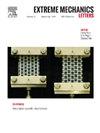Inverse design of mechanical metamaterials balancing manufacturability and compactness: A case study on lattice cells
IF 4.5
3区 工程技术
Q2 MATERIALS SCIENCE, MULTIDISCIPLINARY
引用次数: 0
Abstract
Mechanical metamaterials are artificially engineered structures designed to exhibit unique and extraordinary mechanical properties. In recent years, machine learning has provided a more efficient and systematic approach, enabling inverse design of mechanical metamaterials, which allow for a broader exploration of material properties and support the integration of multifunctionality, significantly speeding up the design process. Despite the many advantages of inverse design, metamaterials often involve a trade-off between competing performance metrics-such as manufacturability and structural compactness. Furthermore, these trade-offs should be dynamically adjusted based on different additive manufacturing conditions. To address this, we proposed a regressional and conditional generative adversarial network based multi-objective (RCGAN-MO) architecture, which simultaneously handles the inverse design and adjustable multi-objective optimization of mechanical metamaterials. The RCGAN-MO includes two trained neural networks: a generator and a predictor, along with a weighted multi-objective optimizer. As a case study, the RCGAN-MO architecture is applied to the inverse design of the relative compressive elastic modulus for a metamaterial, and metamaterials with different weight vector values in the multi-objective optimizer are achieved through 3D printed prototypes. This approach achieves high accuracy and could adjust the importance of manufacturability and compactness, offering a flexible, scalable solution for engineering metamaterials tailored to practical application demands.
平衡可制造性和紧凑性的机械超材料的反设计:以晶格单元为例
机械超材料是人工设计的结构,旨在表现出独特和非凡的机械性能。近年来,机器学习提供了一种更有效、更系统的方法,使机械超材料的逆设计成为可能,从而可以更广泛地探索材料特性,并支持多功能的集成,大大加快了设计过程。尽管逆向设计有许多优点,但超材料通常涉及到竞争性能指标之间的权衡,例如可制造性和结构紧凑性。此外,这些权衡应根据不同的增材制造条件进行动态调整。为了解决这一问题,我们提出了一种基于回归和条件生成对抗网络的多目标(RCGAN-MO)架构,该架构同时处理机械超材料的逆设计和可调多目标优化。RCGAN-MO包括两个经过训练的神经网络:一个生成器和一个预测器,以及一个加权多目标优化器。将RCGAN-MO体系结构应用于某超材料的相对压缩弹性模量反设计中,通过3D打印原型实现了多目标优化器中具有不同权重向量值的超材料。该方法实现了高精度,可以调整可制造性和紧凑性的重要性,为工程超材料提供了一个灵活的、可扩展的解决方案,以满足实际应用需求。
本文章由计算机程序翻译,如有差异,请以英文原文为准。
求助全文
约1分钟内获得全文
求助全文
来源期刊

Extreme Mechanics Letters
Engineering-Mechanics of Materials
CiteScore
9.20
自引率
4.30%
发文量
179
审稿时长
45 days
期刊介绍:
Extreme Mechanics Letters (EML) enables rapid communication of research that highlights the role of mechanics in multi-disciplinary areas across materials science, physics, chemistry, biology, medicine and engineering. Emphasis is on the impact, depth and originality of new concepts, methods and observations at the forefront of applied sciences.
 求助内容:
求助内容: 应助结果提醒方式:
应助结果提醒方式:


